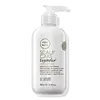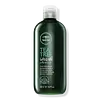What's inside
What's inside
 Key Ingredients
Key Ingredients

 Benefits
Benefits

 Concerns
Concerns

 Ingredients Side-by-side
Ingredients Side-by-side

Water
Skin ConditioningCetyl Alcohol
EmollientStearyl Alcohol
EmollientCetearyl Alcohol
EmollientOleyl Alcohol
EmollientStearamidopropyl Dimethylamine
EmulsifyingMelaleuca Alternifolia Leaf Oil
AntioxidantTrifolium Pratense Flower Extract
AstringentPyridoxine Hcl
Skin ConditioningRosmarinus Officinalis Leaf Extract
AntimicrobialPanax Ginseng Root Extract
EmollientCurcuma Longa Root Extract
MaskingPisum Sativum Peptide
Skin ConditioningTerminalia Ferdinandiana Fruit Extract
AntioxidantLeuconostoc/Radish Root Ferment Filtrate
AntimicrobialDicetyldimonium Chloride
EmulsifyingGlyceryl Stearate
EmollientAmodimethicone/Morpholinomethyl Silsesquioxane Copolymer
Propylene Glycol
HumectantHydroxyethylcellulose
Emulsion StabilisingTrideceth-5
EmulsifyingDisodium EDTA
Citric Acid
BufferingGlycerin
HumectantMyristyl Alcohol
EmollientMagnesium Nitrate
Cetrimonium Chloride
AntimicrobialPhenoxyethanol
PreservativeMethylchloroisothiazolinone
PreservativeMethylisothiazolinone
PreservativeCI 16035
Cosmetic ColorantCaramel
Cosmetic ColorantParfum
MaskingLinalool
PerfumingGeraniol
PerfumingWater, Cetyl Alcohol, Stearyl Alcohol, Cetearyl Alcohol, Oleyl Alcohol, Stearamidopropyl Dimethylamine, Melaleuca Alternifolia Leaf Oil, Trifolium Pratense Flower Extract, Pyridoxine Hcl, Rosmarinus Officinalis Leaf Extract, Panax Ginseng Root Extract, Curcuma Longa Root Extract, Pisum Sativum Peptide, Terminalia Ferdinandiana Fruit Extract, Leuconostoc/Radish Root Ferment Filtrate, Dicetyldimonium Chloride, Glyceryl Stearate, Amodimethicone/Morpholinomethyl Silsesquioxane Copolymer, Propylene Glycol, Hydroxyethylcellulose, Trideceth-5, Disodium EDTA, Citric Acid, Glycerin, Myristyl Alcohol, Magnesium Nitrate, Cetrimonium Chloride, Phenoxyethanol, Methylchloroisothiazolinone, Methylisothiazolinone, CI 16035, Caramel, Parfum, Linalool, Geraniol
Water
Skin ConditioningSodium Laureth Sulfate
CleansingSodium Lauryl Sulfate
CleansingCocamide Mipa
EmulsifyingParfum
MaskingCocamidopropyl Betaine
CleansingPanthenol
Skin ConditioningMelaleuca Alternifolia Leaf Oil
AntioxidantMenthol
MaskingHedychium Coronarium Flower/Leaf/Stem Extract
Skin ConditioningTriticum Vulgare Germ Oil
EmollientAlgae Extract
EmollientSimmondsia Chinensis Leaf Extract
HumectantAloe Barbadensis Leaf Extract
EmollientAnthemis Nobilis Flower Extract
MaskingRosmarinus Officinalis Leaf Extract
AntimicrobialGlycerin
HumectantOleamidopropyl Betaine
CleansingPropylene Glycol
HumectantGlycol Stearate
EmollientPEG-150 Distearate
EmulsifyingCitric Acid
BufferingTetrasodium EDTA
Polyquaternium-7
Bisamino PEG/PPG-41/3 Aminoethyl Pg-Propyl Dimethicone
PEG-12 Dimethicone
Skin ConditioningMethylchloroisothiazolinone
PreservativeMethylisothiazolinone
PreservativeMagnesium Chloride
Magnesium Nitrate
Limonene
PerfumingLinalool
PerfumingCitronellol
PerfumingCI 42090
Cosmetic ColorantCI 19140
Cosmetic ColorantWater, Sodium Laureth Sulfate, Sodium Lauryl Sulfate, Cocamide Mipa, Parfum, Cocamidopropyl Betaine, Panthenol, Melaleuca Alternifolia Leaf Oil, Menthol, Hedychium Coronarium Flower/Leaf/Stem Extract, Triticum Vulgare Germ Oil, Algae Extract, Simmondsia Chinensis Leaf Extract, Aloe Barbadensis Leaf Extract, Anthemis Nobilis Flower Extract, Rosmarinus Officinalis Leaf Extract, Glycerin, Oleamidopropyl Betaine, Propylene Glycol, Glycol Stearate, PEG-150 Distearate, Citric Acid, Tetrasodium EDTA, Polyquaternium-7, Bisamino PEG/PPG-41/3 Aminoethyl Pg-Propyl Dimethicone, PEG-12 Dimethicone, Methylchloroisothiazolinone, Methylisothiazolinone, Magnesium Chloride, Magnesium Nitrate, Limonene, Linalool, Citronellol, CI 42090, CI 19140
 Reviews
Reviews

Ingredients Explained
These ingredients are found in both products.
Ingredients higher up in an ingredient list are typically present in a larger amount.
Citric Acid is an alpha hydroxy acid (AHA) naturally found in citrus fruits like oranges, lemons, and limes.
Like other AHAs, citric acid can exfoliate skin by breaking down the bonds that hold dead skin cells together. This helps reveal smoother and brighter skin underneath.
However, this exfoliating effect only happens at high concentrations (20%) which can be hard to find in cosmetic products.
Due to this, citric acid is usually included in small amounts as a pH adjuster. This helps keep products slightly more acidic and compatible with skin's natural pH.
In skincare formulas, citric acid can:
While it can provide some skin benefits, research shows lactic acid and glycolic acid are generally more effective and less irritating exfoliants.
Most citric acid used in skincare today is made by fermenting sugars (usually from molasses). This synthetic version is identical to the natural citrus form but easier to stabilize and use in formulations.
Read more about some other popular AHA's here:
Learn more about Citric AcidGlycerin is already naturally found in your skin. It helps moisturize and protect your skin.
A study from 2016 found glycerin to be more effective as a humectant than AHAs and hyaluronic acid.
As a humectant, it helps the skin stay hydrated by pulling moisture to your skin. The low molecular weight of glycerin allows it to pull moisture into the deeper layers of your skin.
Hydrated skin improves your skin barrier; Your skin barrier helps protect against irritants and bacteria.
Glycerin has also been found to have antimicrobial and antiviral properties. Due to these properties, glycerin is often used in wound and burn treatments.
In cosmetics, glycerin is usually derived from plants such as soybean or palm. However, it can also be sourced from animals, such as tallow or animal fat.
This ingredient is organic, colorless, odorless, and non-toxic.
Glycerin is the name for this ingredient in American English. British English uses Glycerol/Glycerine.
Learn more about GlycerinLinalool is a fragrance and helps add scent to products. It's derived from common plants such as cinnamon, mint, citrus, and lavender.
Like Limonene, this ingredient oxidizes when exposed to air. Oxidized linalool can cause allergies and skin sensitivity.
This ingredient has a scent that is floral, spicy tropical, and citrus-like.
Learn more about LinaloolWe don't have a description for Magnesium Nitrate yet.
This tea tree oil comes from the leaves of the Tea Tree plant. Tea tree oil has antioxidant, anti-inflammatory, and antimicrobial properties.
According to the book Journal of Profiles of Drug Substances, tea tree helps in reducing acne-causing bacteria such as Propionibacterium acnes. This is due to the Terpinen components of tea tree oil.
Tea tree may cause sensitivity and irritation for some people. This oil naturally contains fragrance such as linalool and limonene.
However, research shows irritation usually occurs when using pure tea tree oil and not in cosmetic products.
Tea tree oil was found to help relieve the symptoms of psoriasis in one study.
Tea tree oil is toxic when ingested. Another study showed it to caused damage to the nervous system of dogs and cats when applied to their skin or given orally.
Learn more about Melaleuca Alternifolia Leaf OilMCI is a preservative and known skin-irritant. It has anti-bacteria anti-fungal properties.
Studies spanning several decades have shown this ingredient to cause skin irritation and allergies.
MCI is commonly combined with methylisothiazolinone (MI). Other names for this mixture include Kathon CG and Euxyl K 100.
The use of this ingredient varies around the world:
Learn more about MethylchloroisothiazolinoneMI is a preservative and known skin irritant. In the past, MI was used for its ability to prevent bacteria, yeast, and fungi growth in low doses.
Nowadays, you'll most likely see MI combined with Methylchloroisothiazolinone (MCI). Trade names for this combination include Kathon CG or Euxyl K 100.
Since then, numerous studies have shown this ingredient to cause contact dermatitis, or skin irritation.
The use of this ingredient varies around the world:
Learn more about MethylisothiazolinoneParfum is a catch-all term for an ingredient or more that is used to give a scent to products.
Also called "fragrance", this ingredient can be a blend of hundreds of chemicals or plant oils. This means every product with "fragrance" or "parfum" in the ingredients list is a different mixture.
For instance, Habanolide is a proprietary trade name for a specific aroma chemical. When used as a fragrance ingredient in cosmetics, most aroma chemicals fall under the broad labeling category of “FRAGRANCE” or “PARFUM” according to EU and US regulations.
The term 'parfum' or 'fragrance' is not regulated in many countries. In many cases, it is up to the brand to define this term.
For instance, many brands choose to label themselves as "fragrance-free" because they are not using synthetic fragrances. However, their products may still contain ingredients such as essential oils that are considered a fragrance by INCI standards.
One example is Calendula flower extract. Calendula is an essential oil that still imparts a scent or 'fragrance'.
Depending on the blend, the ingredients in the mixture can cause allergies and sensitivities on the skin. Some ingredients that are known EU allergens include linalool and citronellol.
Parfum can also be used to mask or cover an unpleasant scent.
The bottom line is: not all fragrances/parfum/ingredients are created equally. If you are worried about fragrances, we recommend taking a closer look at an ingredient. And of course, we always recommend speaking with a professional.
Learn more about ParfumPropylene Glycol is an odorless, colorless liquid. As a humectant, it helps skin retain moisture. It also aids in delivering active ingredients.
Another role of this ingredient is preventing a product from melting or freezing. Propylene glycol also adds antimicrobrial properties to a product, elongating product lifespan.
This ingredient is considered an organic alcohol and commonly added into both cosmetics and foods.
Those with sensitive skin or conditions may develop a rash when using this ingredient.
Learn more about Propylene GlycolRosmarinus Officinalis Leaf Extract comes from rosemary. Rosemary is native to the Mediterranean.
While Rosmarinus Officinalis Leaf Oil can be volatile due to its fragrant properties, the fragrance components are usually removed in the leaf extract.
Rosemary Leaf Extract contains many antioxidants such as rosmarinic acid and caffeic acid. Rosemarinic acid, a compound found in rosemary leaf, has been found to help soothe skin conditions such as eczema and acne.
Learn more about Rosmarinus Officinalis Leaf ExtractWater. It's the most common cosmetic ingredient of all. You'll usually see it at the top of ingredient lists, meaning that it makes up the largest part of the product.
So why is it so popular? Water most often acts as a solvent - this means that it helps dissolve other ingredients into the formulation.
You'll also recognize water as that liquid we all need to stay alive. If you see this, drink a glass of water. Stay hydrated!
Learn more about Water